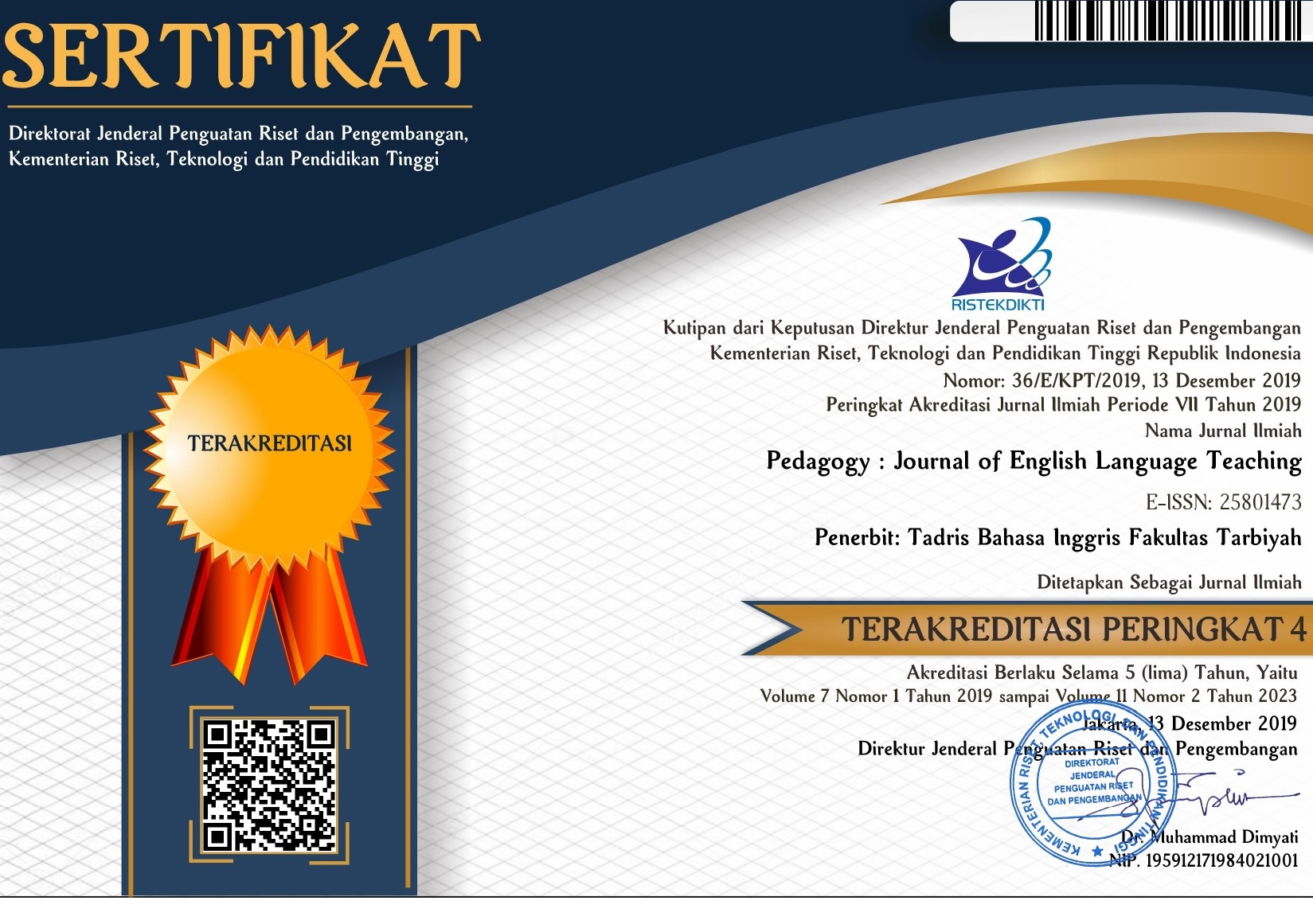The Effect Of Creativity Toward Students’ Achievement in Writing Ability
DOI:
https://doi.org/10.32332/pedagogy.v6i2.1330Keywords:
Creativity, Students’ Achievement, WritingAbstract
Writing is an activity to write and reformulate ideas to create meaning on a paper. In teaching writing, there are many influences, such as creativity. Creativity is an ability to create new product that can be useful and effective in original of thinking. This research is aimed at finding out whether creativity has significance influences toward writing achievement. The research was conducted at IAIN Metro in the academic year of 2012/2013. The population of this research was the third semester students of English Department of IAIN Metro. The result of this research is the students who have creativity could give significant effects on the students' writing ability and the creativity that was given by the lecturer was effective.
References
Fredericks, A. D. (2005). The complete idiot’s guide to success as a teacher. New York, NY: Alpha.
Galkova, Dita, & Hubackova, Sarka. (2014). Productive skills in second language learning. Procedia - Social and Behavioral Sciences 143 ( 2014 ) 477 – 481. ELSEVIER.
Grainger, Teresa, et al. (2005). Creativity and Writing: Developing Voice and Verve in the Classroom. New York: Routledge Taylor & Francis Group.
Heikkola, Leena Maria, & Alisaari, Jenni. (2016). Increasing fluency in L2 writing with singing. Studies in Second Language Learning and Teaching Journal. Department of English Studies, Faculty of Pedagogy and Fine Arts, Adam Mickiewicz University, Kalisz.
Munandar, Sukarni Catur Utami. (1992). Creativity and Education: Jakarta: Proyek Penggandaan/Penerjemah Buku direktorat Pembinaan Penelitian dan Pengembangan Pada masyarakat Direktorat Jendral Pendidikan Tinggi Departmen Pendidikan dan Kebudayaan.
O’Maggio, A. (1936). Teaching Lunguage in Context. Boston: Heinle & Heinle.
Pei, Zhengwei, Zhang, Chaqom, et.all. (2017). Critical Thinking and Argumentative Writing: Inspecting the Association among EFL Learners in China. English Language Teaching; Vol. 10, No. 10; ISSN 1916-4742 E-ISSN 1916-4750. Canadian Center of Science and Education.
Sharp, Laurie. A. (2016). Acts of Writing: A Compilation of Six Models that Define the Processes of Writing. International Journal of Instruction. Vol.9, No.2. e-ISSN: 1308-1470 ● www.e-iji.net.
Sugiyono. 2011. Metode Penelitian Kuantitatif, Kualitatif dan R&D. Bandung: Afabeta.
Tompkins, G. E. (1994). Teaching Writing: Balancing Process and Product. NY:Merrill.
Trnova, Eva. (2014). IBSE and Creativity Development. Science Education International. Vol. 25, Issue 1. International Council of Assosiation for Science Education.
Tung, Chan Kwang. ( 2015). Assessment of Creative Writing: The Case of Singapore Secondary Chinese Language Curriculum. Universal Journal of Educational Research 3(10): 655-662. DOI: 10.13189/ujer.2015.031001.
Yagcioglu, Ozlem. (2016). Increasing Creativity With The Self-Studies In Basic English Classes. European Journal of English Language Teaching. Vol.1, No.2. I-SSN: 2501-7136.
Ying, Zhang. (2018). Exploring Construction of College English Writing Course from the Perspective of Output-Driven Hypothesis. English Language Teaching Journal. Vol11. No.2. ISSN 1916-4742 E-ISSN 1916-4750. Canadian Center of Science and Education
Zainudin, Mochamed. (2004). The Effect of Giving Feedback to Students’ Writing. TEFLIN Journal. Vol. 15, No.2.
Galkova, Dita, & Hubackova, Sarka. (2014). Productive skills in second language learning. Procedia - Social and Behavioral Sciences 143 ( 2014 ) 477 – 481. ELSEVIER.
Grainger, Teresa, et al. (2005). Creativity and Writing: Developing Voice and Verve in the Classroom. New York: Routledge Taylor & Francis Group.
Heikkola, Leena Maria, & Alisaari, Jenni. (2016). Increasing fluency in L2 writing with singing. Studies in Second Language Learning and Teaching Journal. Department of English Studies, Faculty of Pedagogy and Fine Arts, Adam Mickiewicz University, Kalisz.
Munandar, Sukarni Catur Utami. (1992). Creativity and Education: Jakarta: Proyek Penggandaan/Penerjemah Buku direktorat Pembinaan Penelitian dan Pengembangan Pada masyarakat Direktorat Jendral Pendidikan Tinggi Departmen Pendidikan dan Kebudayaan.
O’Maggio, A. (1936). Teaching Lunguage in Context. Boston: Heinle & Heinle.
Pei, Zhengwei, Zhang, Chaqom, et.all. (2017). Critical Thinking and Argumentative Writing: Inspecting the Association among EFL Learners in China. English Language Teaching; Vol. 10, No. 10; ISSN 1916-4742 E-ISSN 1916-4750. Canadian Center of Science and Education.
Sharp, Laurie. A. (2016). Acts of Writing: A Compilation of Six Models that Define the Processes of Writing. International Journal of Instruction. Vol.9, No.2. e-ISSN: 1308-1470 ● www.e-iji.net.
Sugiyono. 2011. Metode Penelitian Kuantitatif, Kualitatif dan R&D. Bandung: Afabeta.
Tompkins, G. E. (1994). Teaching Writing: Balancing Process and Product. NY:Merrill.
Trnova, Eva. (2014). IBSE and Creativity Development. Science Education International. Vol. 25, Issue 1. International Council of Assosiation for Science Education.
Tung, Chan Kwang. ( 2015). Assessment of Creative Writing: The Case of Singapore Secondary Chinese Language Curriculum. Universal Journal of Educational Research 3(10): 655-662. DOI: 10.13189/ujer.2015.031001.
Yagcioglu, Ozlem. (2016). Increasing Creativity With The Self-Studies In Basic English Classes. European Journal of English Language Teaching. Vol.1, No.2. I-SSN: 2501-7136.
Ying, Zhang. (2018). Exploring Construction of College English Writing Course from the Perspective of Output-Driven Hypothesis. English Language Teaching Journal. Vol11. No.2. ISSN 1916-4742 E-ISSN 1916-4750. Canadian Center of Science and Education
Zainudin, Mochamed. (2004). The Effect of Giving Feedback to Students’ Writing. TEFLIN Journal. Vol. 15, No.2.
Downloads
Published
2019-02-22
Issue
Section
Articles















